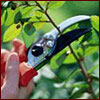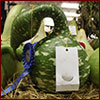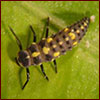The Neighborhood Gardener – March

Happy gardening!
Disinfecting Garden Tools
 Get ready for spring and the busy gardening season ahead by taking some time to disinfect your horticultural tools. Regularly disinfecting your tools is a good way to prevent disease from spreading in your landscape. There are multiple products available—regardless of which you choose, it's always important to read and understand label instructions before using any cleaning product. More
Get ready for spring and the busy gardening season ahead by taking some time to disinfect your horticultural tools. Regularly disinfecting your tools is a good way to prevent disease from spreading in your landscape. There are multiple products available—regardless of which you choose, it's always important to read and understand label instructions before using any cleaning product. More
Fertilizer Basics
Speaking of labels, the one on your bag of fertilizer is another important label you should be reading and understanding before using the product. Fertilizer labels include a series of numbers that indicate the respective percentage of nitrogen, phosphorus, and potassium by weight. Remember, you should only apply as much fertilizer as your plants can use and always fertilize responsibly. More
Plant of the Month: Bottle Gourds
 Bottle gourds (Lagenaria spp.) are annual vines that can be grown throughout the state. Young, small fruits can be eaten, but it's the mature fruits that are valued for making useful and durable containers. Grown for centuries, it is the only crop known to have been cultivated in pre-Columbian times in both the Old and New World. Plant your bottle gourd vine like any squash plant. A trellis is advised, but vines may be allowed to run on the ground; be sure to add mulch to avoid fruit rotting. More
Bottle gourds (Lagenaria spp.) are annual vines that can be grown throughout the state. Young, small fruits can be eaten, but it's the mature fruits that are valued for making useful and durable containers. Grown for centuries, it is the only crop known to have been cultivated in pre-Columbian times in both the Old and New World. Plant your bottle gourd vine like any squash plant. A trellis is advised, but vines may be allowed to run on the ground; be sure to add mulch to avoid fruit rotting. More
March in Your Garden
Plant warm season crops now, like beans, cucumbers, sweet corn, and squash. Now is a good time to check your irrigation system for any issues. Refresh and add mulch to your landscape beds; it conserves soil moisture, insulates roots from extreme temperatures, and minimizes weeds.
For more month-by-month gardening tips, check out the Florida Gardening Calendar. Three different editions of the calendar provide specific tips for each of Florida's gardening regions—North, Central, and South.
Friend or Foe? Friend: Ladybug Larvae
 Keep an eye out for ladybug larvae. Gardeners "in the know" welcome these tiny insects, as the larvae feed on garden pests like aphids and psyllids. You might be hard-pressed to recognize them, however. There are many species of ladybugs, and their larvae all look very different. The larvae of one species, Cryptolaemus montrouzieri Mulsant, even resembles its prey, mealybugs! Letting these little critters mature safely can help keep your plants pest-free in the coming spring. See photos of various species of ladybugs at UF/IFAS Featured Creatures.
Keep an eye out for ladybug larvae. Gardeners "in the know" welcome these tiny insects, as the larvae feed on garden pests like aphids and psyllids. You might be hard-pressed to recognize them, however. There are many species of ladybugs, and their larvae all look very different. The larvae of one species, Cryptolaemus montrouzieri Mulsant, even resembles its prey, mealybugs! Letting these little critters mature safely can help keep your plants pest-free in the coming spring. See photos of various species of ladybugs at UF/IFAS Featured Creatures.
Do You Have a Success Story?
We're looking for inspiring, Florida-Friendly success stories from your county. Submit yours today to Emily Eubanks.
What's Going On?
If your Master Gardener program or Extension office is having an event, be sure to share it with us.

